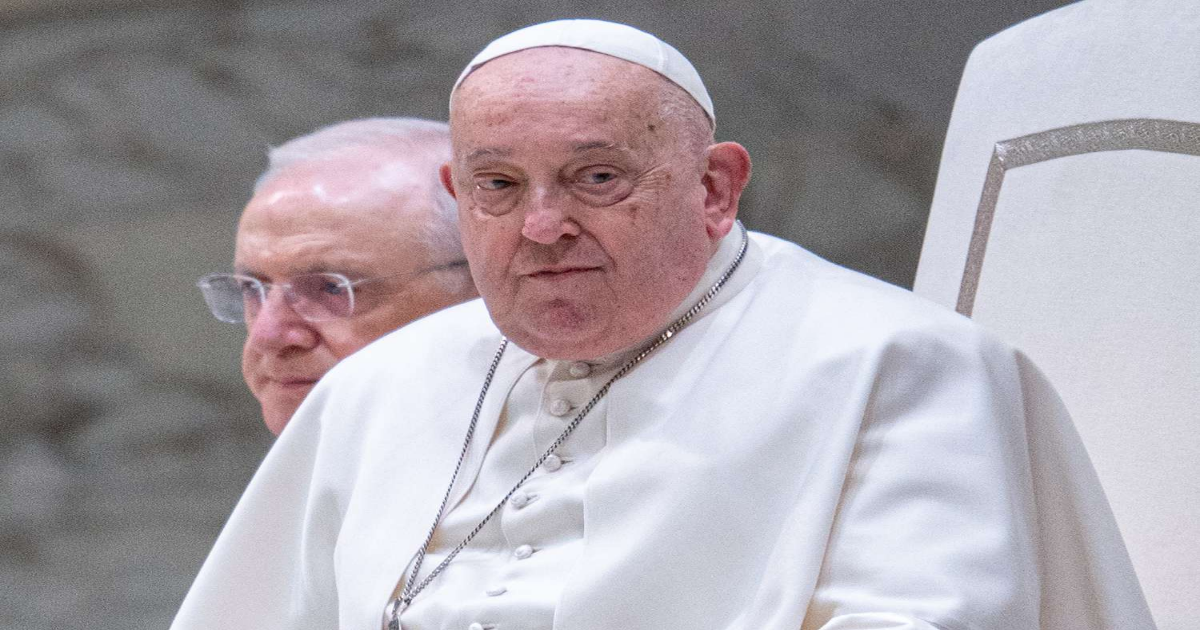Pope Francis attends the weekly general audience in the Vatican, on Feb. 12, 2025. Photo:
Massimo Valicchia/NurPhoto via Getty
- Pope Francis died on Monday, April 21, at the age of 88
- His death comes just under a month after the pontiff was discharged from the hospital following a 38-day stay for bronchitis and pneumonia
- From his funeral to when a new pope will be decided, here’s what happens after a pope dies
The news of Pope Francis‘ death at 88 on Monday, April 21, sets off a series of events, some of which have been in place for centuries, while others were dictated by Francis himself in recent years.
Back in 2023, Francis revealed that he had already met with the Papal Master of Ceremonies to plan his funeral, even joking that he would be the one to “premiere” the new, simplified ritual.
From where he’ll be buried to when cardinals will elect his successor, here’s what happens after a pope dies. farrell prside over conclave to select the next one
Traditionally, after a pope dies, the carmelango, who is the pope’s chief of staff, calls out the pontiff’s baptismal name three times. If the pontiff does not respond, a certificate of death is authorized and the cardinal vicar for the Diocese of Rome is notified.
As part of custom, the deceased pontiff’s Fisherman’s Ring is destroyed by the carmelango to signify the end of his authority. His papal apartments will also be blocked off.
Before his death is announced to the world by the Vatican, the camerlengo will also inform the College of Cardinals of the pope’s death.
News of the pope’s death will trigger a nine-day period of mourning, known as Novendiale.
During that time, the pope’s body will be blessed and lie in state at St. Peter’s Basilica in Vatican City for viewing, according to Politico. His funeral will take place sometime between the fourth and sixth day after his death and will take place at St. Peter’s Square, weather permitting, CBS News reported.
Last year, Francis approved new funeral rites that would call for his body to be on view in a simple coffin rather than being placed on an elevated bier, the Associated Press reported. Additionally, his burial would no longer require the traditional three coffins consisting of cypress, lead and oak.
As for where he will be buried, in 2023, Francis told a Mexican broadcaster that he wants to be buried in St. Mary Major, a Rome basilica, instead of the Vatican. He expressed a desire to be near an icon of the Virgin Mary that is on display at the basilica. St. Mary Major is also where the pontiff prays before and after his foreign visits, according to Reuters.
“It’s my great devotion,” Francis said. “The place is already prepared.”
Pope Francis speaking at the Vatican in February 2025. Vatican Media via Vatican Pool/Getty
Papal funerals are deemed as public events, the National Catholic Register reported. And even with the new simplified rites for his funeral that Francis approved, his body will still be on display at St. Peter’s Basilica for public viewing before the funeral, according to National Catholic Reporter.
Hundreds of thousands of people — including foreign representatives and world leaders — are expected to line up and pay their respects, per Politico.
Never miss a story — sign up for PEOPLE’s free daily newsletter to stay up-to-date on the best of what PEOPLE has to offer, from celebrity news to compelling human interest stories.
After Pope Benedict XVI died on Dec. 31, 2022, following his retirement in 2013, his funeral was attended by an estimated 50,000 people in St. Peter’s Square, the Guardian reported. The news outlet added that 200,000 saw the pontiff lie in state over the course of three days, according to Vatican officials.
In comparison, about 300,000 people were in the square for the funeral of Pope John Paul II in 2005, Voice of America reported.
Within two or three weeks after the funeral, the cardinals will assemble and have a meeting (conclave) to talk about electing a new pope, Bill Cavanaugh, an American Catholic theologian and professor of Catholic studies at DePaul University, tells PEOPLE.
“The cardinals will lock themselves into the Sistine Chapel and discuss and vote on the next pope,” he explains. “Not every cardinal can vote. Only cardinals who are under 80 can vote. And a papal candidate needs two-thirds of the vote of the voting cardinals to be elected.”
Meanwhile, Kathleen Sprows Cummings, a nationally recognized expert on Pope Francis, notes that many of the cardinals Francis appointed during his time as pope were from Asia, South America and Africa rather than Europe.
“It’s about 80% of the 141 cardinal electors are the ones that will be choosing his successor, and they will have conversations after the funeral,” adds Cummings, “There will be these things called general congregations, which is where they all get together and talk about the needs, all the cardinals, so not just the cardinal electors.”
After each vote, says Cummings, smoke is sent up the chimney of the Sistine Chapel. “If it’s black, it means they have not elected a pope,” she says. “And then if it’s white, that means that we have a new pope.”
As for who might succeed Francis, experts say that since the late pope appointed many cardinals, his successor could be someone who shares his ideas and vision for the church, but there’s no guarantee.
“The conclave people like to say that it’s actually the Holy Spirit that chooses the new pope, which is something that I think Catholic believers like to think and hope and pray,” says Cummings. ”But anything can happen. And it’s not like there’s a clear front runner right now. There’s a lot of speculation. Will it be back to another European pope, which could happen, or will it be another pope from the global south, from Asia, from Africa. We just don’t know.”



